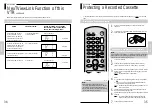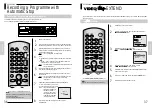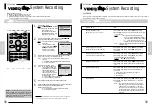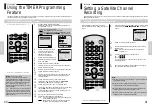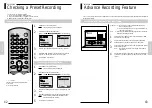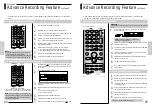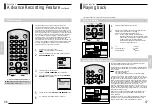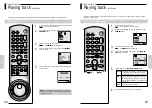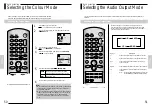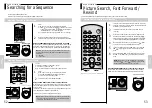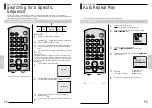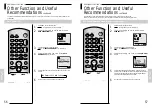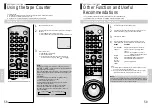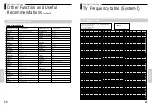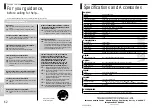
V853UK
66
GLOSSARY
Specifications and Accessories
European Service Centre
l
Admiralty Way
l
Camberley
l
Surrey
l
GU15 3DT
Telephone 01276 62222
Printed in Indonesia
AC68-01763B
SYSTEM
Format:
VHS PAL standard
Recording system:
Rotary, helical scan system
Heads:
6 head
Video signal system:
CCIR; 625 lines, 50 fields, PAL colour signal, NTSC colour, 525 lines
Tape speed:
SP: 23.39mm/s (PAL)
SP: 33.35mm/s (NTSC)
LP: 11.69mm/s (PAL)
SLP: 11.12mm/s (NTSC)
Recording time:
SP: 3 hours with E180
LP: 6 hours with E180
Winding time:
About 1 minute with E180 cassettes
Dimensions:
430(w) x 94(h) x 240(d)mm
Mass:
3,5 kg approx.
Operating temperature:
+5 to +40˚C
Operating humidity:
10%-75%
Mains power:
220 ~ 240V AC, 50Hz
Power consumption:
17W
CONNECTORS
Aerial input:
75
Ω
coaxial
Aerial output:
75
Ω
coaxial
Video input:
IN/OUT SCART socket 1.0V(p-p), 75
Ω
Audio input:
IN/OUT SCART socket, 308mV(rms), more than 10 k
Ω
Video output:
IN/OUT SCART socket, 1.0 V(p-p), 75
Ω
Audio output:
IN/OUT SCART socket, 308 mV(rms), less than 1.0 k
Ω
AUDIO OUT Phono socket, 308 mV(rms), less than 4,7 k
Ω
VIDEO
Signal-to-noise ratio:
More than 43dB (SP tape speed/PAL)
AUDIO
Signal-to-noise ratio:
More than 42dB (SP tape speed/PAL/normal mono)
Frequency range:
20Hz to 20kHz
Dynamic range:
More than 90dB
Audio Track:
1 Track (normal-mono), 2 Channels (Hi-Fi sound)
TIMER
Clock:
24-hour digital indication
No of events:
6 events 1 month
TUNER
System:
Frequency synthesizer
Channel coverage:
PAL-I VHF: A – J, 11, 13, E2 – E12 UHF: E21 – E69
CATV: X, Y, Z, S1 – S41, 1 – 53 (48MHz to 464MHz, 8MHz steps)
Stereo:
NICAM-I
RF converter:
UHF 21 – 69 (adjustable), System-I (Preset : CH36)
ACCESSORIES
Aerial cable x 1 Remote Controller x 1 (batteries UM-4, AAA, IEC R03 x 2)
Design and specifications are subject to change without notice.
62
PROBLEM SOLVING
For your guidance,
before calling for help...
Problem and Solutions
Before contacting the after-sales service, perform the following simple checks.
66
If you get any problems
contact the helpline…
No power...
Check that the power plug is connected to a wall
outlet.
have you pressed the VTR ON/STANDBY button?
You cannot insert a video cassette...
A video cassette can only be inserted with the window
side up and the safety tab facing you.
The television programme was not recorded...
Check the VTR aerial connections.
Is the VTR tuner properly set?
Check if the safety tab is intact on the cassette.
Timer recording was unsuccessful...
Was the two TIMER buttons pressed to activate the
timer?
Re-check the recording start/stop time settings.
If there was a power failure or interruption during
timer recording, the recording will have been
cancelled.
No playback picture or the picture is distorted...
Check to see if you are using a prerecorded tape.
You cannot see normal broadcasts...
Check the TUNER/EXTERNAL setting. it should be on
TUNER.
Check the TV/VTR aerial connections.
Noise bars or streaks on playback...
Press the CH/TRK (
i
or
j
) buttons to minimize this
effect.
PROBLEM SOL
VING
When the PAUSE/STILL (
❙❙
) button is pressed
during playback, the still picture has severe
“noise bars” streaks...
A still picture may have “noise bars”, depending on
the condition of the tape.Press the CH/TRK (
i
or
j
)
buttons during SLOW motion to minimize this effect.
Video Head Cleaning...
If poor pictures appear on a variety of cassette, the
video heads may need cleaning. This is not a common
problem and unless it appears, the heads should not
be cleaned. When cleaning the video heads, read all
instruction provided with the head cleaning as it can
permanently damage the video heads.
If when tuning in your TV to the VTR test
pattern your TV does not find the test
pattern or the pattern when found suffers
from interference, it may be due to the
VTR output channel clashing with the
normal TV transmissions in your area. To
prevent this you will need to change the
VTR output channel in the following way...
1. Remove the aerial input plug from the socket
marked (aerial symbol) on the rear of the VTR.
2. Carry out the instructions “Tuning Your television for
the VTR” (see page 12)
3. Carry out the instructions “Setting the VTR output
Channel” (see page 15), move the channel number
several channels down from the original setting
(example : from 60 to 65).
4. Replace the aerial plug into the socket marked
(aerial symbol) on the rear of the VTR.
5. Re-tune your TV to the VTR again by following
instructions “Tuning Your Television for the VTR” (page 12).
6. If the problem still exists repeat steps 1 to 5 moving several
more channels away from the original setting.

